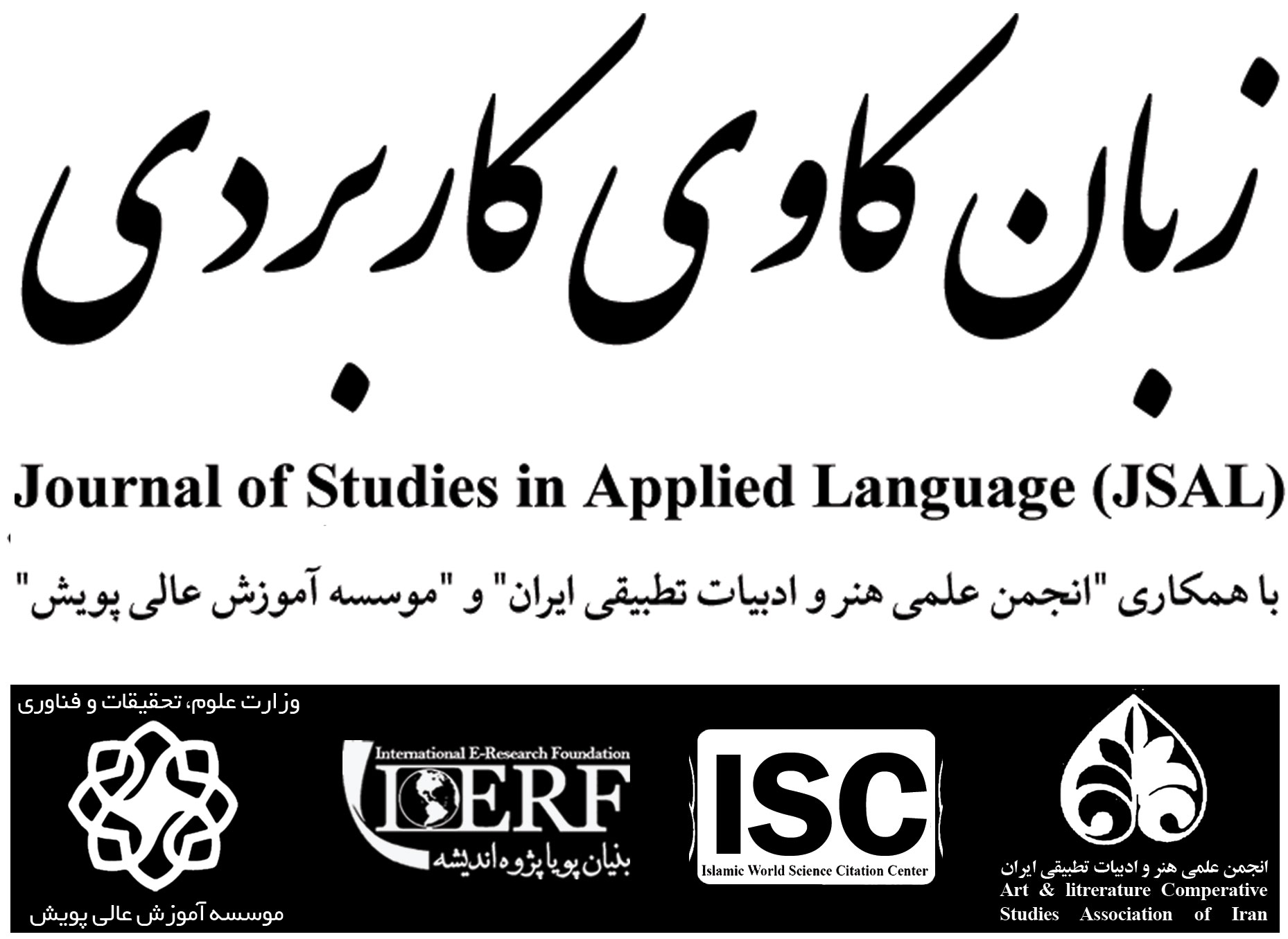<>
Volume 6, Issue 4 (11-2023)
JSAL 2023, 6(4): 47-77 |
Back to browse issues page
Download citation:
BibTeX | RIS | EndNote | Medlars | ProCite | Reference Manager | RefWorks
Send citation to:



BibTeX | RIS | EndNote | Medlars | ProCite | Reference Manager | RefWorks
Send citation to:
Hannan S, Imani Z. (2023). Examination of Derivative and Compound Words Generated from Four Syntactic Elements "-Chi," "-Kar," "-Forush," and "-Gar" within the Context of Morphological Construction Theory [In Persian]. JSAL. 6(4), 47-77. doi:10.61186/jsal.6.4.47
URL: http://jsal.ierf.ir/article-1-106-en.html
URL: http://jsal.ierf.ir/article-1-106-en.html
1- MA Graduate in General Linguistics, Bu-Ali Sina University, Hamedan, Iran
2- PhD Candidate in General Linguistics, University of Isfahan, Isfahan, Iran ,zolfa.imani.1985@gmail.com
2- PhD Candidate in General Linguistics, University of Isfahan, Isfahan, Iran ,
Abstract: (3022 Views)
Within the Persian language, various resources exist for deriving and compounding words to express occupations and professions. These resources generate compound and derivative nouns that convey agentivity and agency when combined with nouns and adjectives. This study aims to investigate the syntactic elements "-Chi," "-Kar," "-Forush," and "-Gar" within the framework of Morphological Construction Theory. The research provides a foundational analysis of how words formed with these suffixes and free morphemes are constructed. Morphological Construction Theory is a recent morphological approach that employs "construction" to describe the systematic relationship between form and meaning in word formation. According to this theory, non-simple words are considered constructions, and each word functions as a linguistic sign, representing the pairing of form and meaning. Each word encompasses three types of information, which are represented by three signs in the lexical approach: PHON (representing the phoneme dimension), SYN (representing the morpheme-syntax dimension), and SEM (representing the semantic dimension of the word). This research takes an empirical corpus-based approach and is theoretically grounded in a cognitive framework. The study data consist of 212 derivative and compound words formed using the suffixes "Chi" and "Gar" and the free morphemes "Forush" and "Kar," extracted from Persian corpora such as Bijankhan, Moin Encyclopedic Dictionary and Dehkhoda Dictionary. The words derived from these elements exhibit 4, 3, 4, and 3 schemas, conveying agentivity and agency in their overall meaning. However, they differ in terms of their reference to the concept of occupation or their basic syntactic role to which each of these four elements is attached. Another significant finding of this research is establishing a bidirectional relationship between construction and meaning, whereby the construction of a word determines the meaning and conceptualization derived from the word as a whole.
Keywords: Sociolinguistics, Morphological Construction Theory, Derivative Words, Compound Words, Semantic Schemas
Type of Study: Research |
Subject:
Sociolinguistics
Received: 2022/09/23 | Accepted: 2023/04/22 | Published: 2023/11/1
Received: 2022/09/23 | Accepted: 2023/04/22 | Published: 2023/11/1
References
1. Azimdokht, Z., Rafiee, A., & Rezaei, H. (2018). "Semantic Variations of Persian Compound Words Ending in the Present Stem -Yɑ̃B: Construction Morphology Approach". Journal of Researches in Linguistics, No. 10, No. 2, pp. 83-102. doi: 10.22108/jrl.2018.109178.1157
2. Azimdokht, Z., Rafiee, A., & Rezaei, H. (2018). "Semantic Variations of Persian Compound Words Ending in the Present Stem -Yɑ̃B: Construction Morphology Approach". Journal of Researches in Linguistics, Vol. 10, No. 2, pp. 83-102. doi: 10.22108/jrl.2018.109178.1157
3. Bamshadi P, Ansarian S. (2020) "The role of second order schemas in the analysis of [N + ʃenɑsi/negɑri/kɑvi]N and their corresponding adjectives in Persian". LRR, Vol. 11, No. 1, pp. 301-328
4. Bamshadi P, Ghatreh F. (2018) The Polysemy of Suffix "-i": An Exploration within the Construction Morphology. LRR, Vol, 8, No. 7, pp. 265-289
5. Bamshadi, P., & Davari Ardakani, N. (2018). A Constructional Cognitive Approach to the Persian Suffix '-gɑr'. Language Research, Vol. 9, No. 2, pp. 45-66. doi: 10.22059/jolr.2018.69528
6. Bamshadi, P., Ansarian, S., & Davari Ardakani, N. (2018). "The Polysemy of Suffix "-ɑne": A Construction Morphology Approach". Journal of Western Iranian Languages and Dialects, Vol. 6, No. 22, pp. 21-39
7. Bamshadi, P., Ansarian, S., & Davari Ardakani, N. (2019). "The Derivational Suffixes '-in' and '-ine' within the Framework of Construction Morphology". Persian Language and Iranian Dialects, Vol. 4, No. 2, pp. 121-144. doi: 10.22124/plid.2019.11241.1307
8. Bamshadi, P., Ansarian, S., & Davari Ardakani, N. (2021). "The Persian Suffixes '-zɑr', '-kæde', and '-estɑn' within the Framework of Construction Morphology". Journal of Western Iranian Languages and Dialects, Vol. 9, No. 1, pp. 21-41. doi: 10.22126/jlw.2021.4336.1316.
9. Booij, G., (2010). Construction Morphology. Oxford: Oxford University Press.
10. Haspelmath, M. (2002). Understanding morphology. 2th ed., London: Hodder Education.
11. Mahmoudi Bakhtiari, B., & Shahhoseini, F. (2015). "Remarks on Embodied Schemata of "kār" Morpheme as a Polysemic Category Based on the Cognitive Morphology Approach". Language and Linguistics, Vol. 11, No. 21, pp. 117-132.
12. Natal Khanleri, P., (2016). Persian grammer. Tehran: Tos Publications.
13. Shaghaghi, V., (2008). The Sarf basics. Tehran: Side Publications.
14. Taki, G., Yousefyan, P., & Moradi, E. (2014). "Investigating the Morphological Structure and Meaning of "-gar" in Persian". Journal of Western Iranian Languages and Dialects, Vol. 1, No. 3, pp. 1-22.
Send email to the article author
| Rights and permissions | |
 |
This work is licensed under a Creative Commons Attribution-NonCommercial 4.0 International License. |








